Paper PSAT score reports have been sent to schools. If you’re reading this, you may have received your own. This post will walk you through what all the elements on this score report mean for you as you prepare for college admissions.
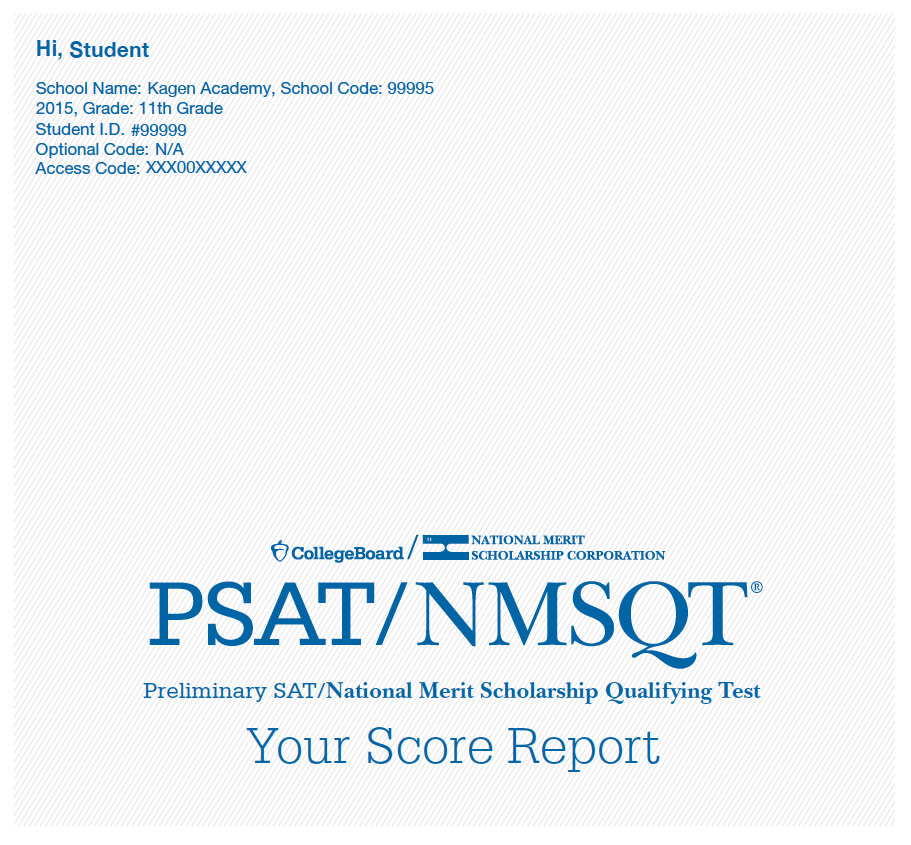 The cover is pretty self-explanatory. Hopefully you’ve received your own score report! You can also access your report (and additional information) online by creating a College Board account. If you haven’t already created an online account, the “Access Code” listed on the cover can help College Board find your scores.
The cover is pretty self-explanatory. Hopefully you’ve received your own score report! You can also access your report (and additional information) online by creating a College Board account. If you haven’t already created an online account, the “Access Code” listed on the cover can help College Board find your scores.
There are two groups involved in this test: College Board and National Merit Scholarship Corporation (NMSC). The College Board makes the SAT and PSAT. It’s important to remember that the P in PSAT stands for preliminary; this is a practice test for the SAT. No college will ever see these scores. The NMSC, however, uses this test as a way to identify students for its scholarship program. Though both sophomores and juniors may take the PSAT, only juniors are eligible for National Merit recognition. You don’t need to apply for National Merit—you will be notified if you’re eligible, but that won’t be until September of senior year. See the explanation of the NMSC Selection Index below for more information.
Below this title is information about what the College Board thinks you can do with this info: (a) practice on Khan, (b) identify AP courses that may be a good fit for you based on scores, and (c) take the real SAT.  As far as free practice on Khan Academy goes, you can read our take on that prep elsewhere on the blog. In short, practice can help, but Khan will most likely help those students who are already strong test takers and have a great deal of self-discipline. For the rest of us, having a tutor or coach can be a huge help. When it comes to APs, your high school counselors and teachers are often the best resources for helping you select which classes are right for you. And if you’re thinking you enjoyed (or perhaps, didn’t hate) the PSAT, then maybe you do want to register for the SAT, but there are good reasons for taking a practice ACT and then comparing your scores to see which test is actually the better fit.
As far as free practice on Khan Academy goes, you can read our take on that prep elsewhere on the blog. In short, practice can help, but Khan will most likely help those students who are already strong test takers and have a great deal of self-discipline. For the rest of us, having a tutor or coach can be a huge help. When it comes to APs, your high school counselors and teachers are often the best resources for helping you select which classes are right for you. And if you’re thinking you enjoyed (or perhaps, didn’t hate) the PSAT, then maybe you do want to register for the SAT, but there are good reasons for taking a practice ACT and then comparing your scores to see which test is actually the better fit.
At the top of page two, you find the most important items: your scores. In the middle is your “Total Score,” which is the sum of your two section scores.
The first two portions of the PSAT—the first asked you to read passages and then answer questions, and the second asked you to edit someone else’s writing—are combined into your “Evidence-Based Reading and Writing Score.” That’s a bit of a mouthful, but the College Board wants to emphasize that you’re being asked to find evidence for your answers—it’s not a subjective test. The “Math Score” is made up of the two math portions: the first without calculator and the second with calculator.
Note that it says “160 to 760” next to each section score. This is one of Fall 2015’s big changes! Prior to that, the PSAT was on a scale of 20–80, and students were told to “add a 0” to figure out where they were headed on the SAT. Now the PSAT and SAT are on the same scale, but the PSAT score range occupies a lower position on the scale because the PSAT is slightly easier than the SAT. As a result, the top score on a PSAT section is 760 instead of the 800 on the SAT. The highest total score possible for the PSAT is 1520, while the highest total score for the SAT is 1600.
The score you see on your PSAT is the score you’d likely receive if you were to take the SAT right now with no further prep.
Right below your scores is a bunch of information that you can probably ignore. The “Nationally Representative Sample Percentile” might seem like a way for you to compare your performances on the SAT and ACT or your performance against that of past students, but be careful! With the new test, the College Board has changed the way it defines and reports percentiles; a 92nd percentile on the new PSAT does not equal a 92nd percentile on the old PSAT. These new percentiles are a bit inflated because they include students who would normally not take the PSAT. To get a sense of how you’ve done in comparison to other college-bound students, you should visit your online report and look at your “User Percentile—National.” The “User Percentile” is also the type of percentile that the ACT offers; however, because the PSAT and ACT are different assessments taken by different populations, making prep decisions based solely on a comparison of percentiles across the two tests is not advisable.
Following percentiles are your “College and Career Readiness Benchmarks.” If your placement on these bars motivates you to study and do well in school, awesome! If it just looks like a bunch of stressful numbers, ignore! There are big questions about how the College Board arrived at the benchmarks, and these numbers are more for policy makers than for college admissions officers.
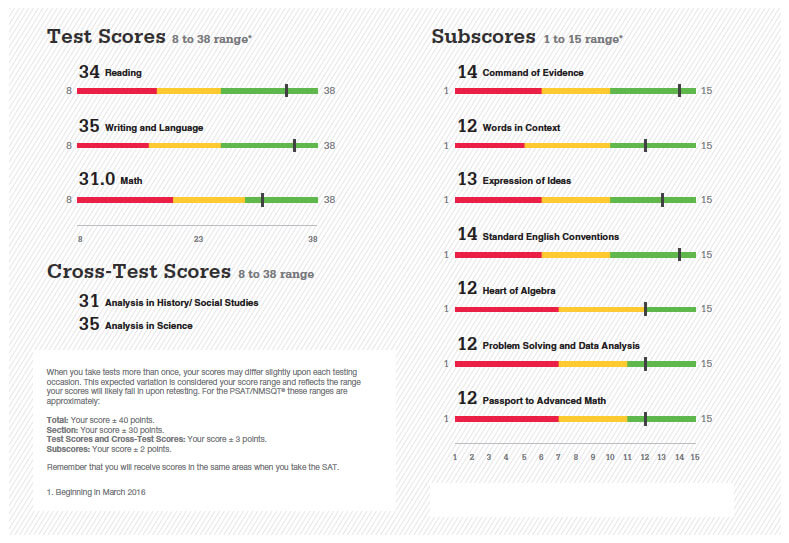 The bottom half of the page shows a variety of test, subtest, and cross-test scores.
The bottom half of the page shows a variety of test, subtest, and cross-test scores.
The Test Scores split out Reading from Writing and Language to help you see which area needs more improvement, and they help to calculate your National Merit Selection Index (see below). The the sub- and cross-test scores are more for educators and policy makers than they are for students or college admissions. But they look fancy, no?
One thing that is important: THE FINE PRINT! Check out the bottom left of this page. What this is telling you is that while a 620 on PSAT math is a good indication of how you would have done on the SAT, because of natural variations, you should really add a +/- 30 points to that score. And your total score? That’s really a range of +/- 40 points. Why does this matter? It matters because college admission officers know that small score differences should not be used to differentiate applicants.
On to Page 3! Let’s talk National Merit for a moment.
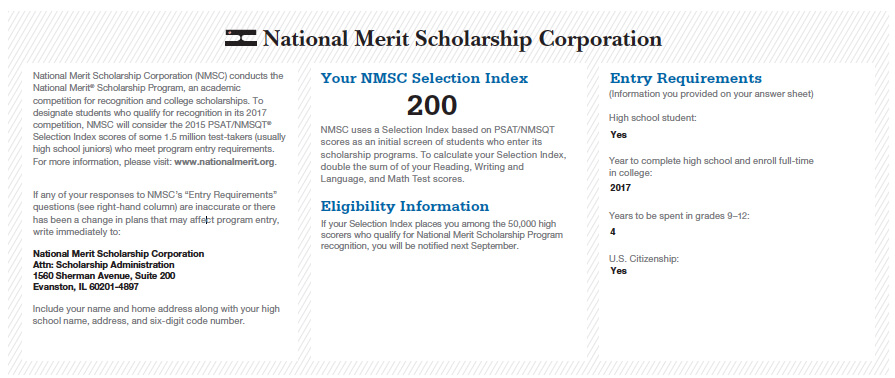 Each state has a different cut-off for students to receive Semifinalist status. That cut-off is based on your NMSC Selection Index—the number you see in the middle.
Each state has a different cut-off for students to receive Semifinalist status. That cut-off is based on your NMSC Selection Index—the number you see in the middle.
Your Selection Index = 2 x (Reading Test Score + Writing and Language Test Score + Math Test Score)
Note that those are TEST SCORES, not section scores. Each Test Score is out of 38.
The highest SI is 228 because 2 x (38 + 38 + 38) = 228. As you may have noticed, verbal skills are weighted more heavily than math skills by the NMSC.
The number of students who receive Semifinalist status (about 16,000 students) has remained consistent. Please see our posts on National Merit for more information.
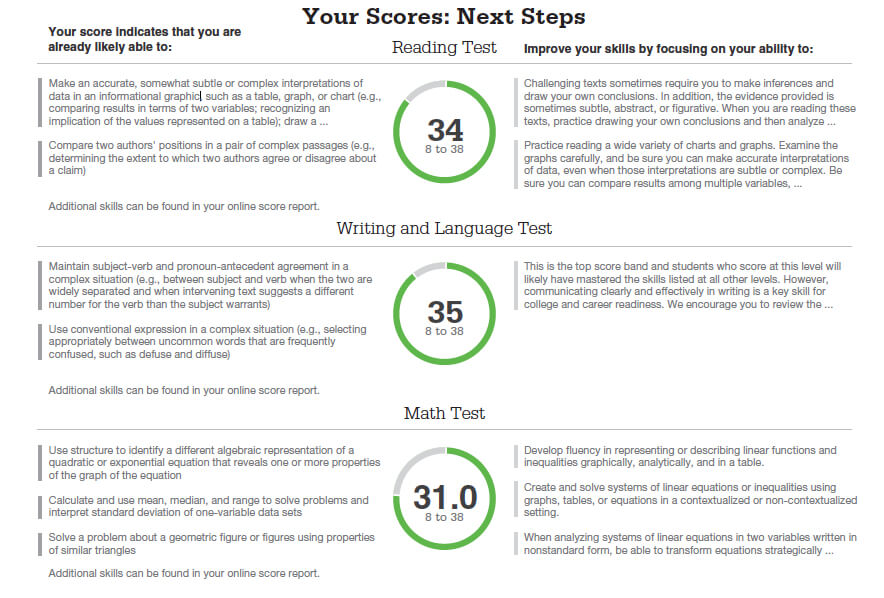 Your report next wants to tell you about what skills you need to improve, but in truth, this guidance is so general that it may not be much help. While the College Board wants to give you feedback on your performance, it also wants to make sure you take the SAT instead of the ACT. All of this extra information is designed, in part, to help convince you that you can improve your scores if you stick with the SAT.
Your report next wants to tell you about what skills you need to improve, but in truth, this guidance is so general that it may not be much help. While the College Board wants to give you feedback on your performance, it also wants to make sure you take the SAT instead of the ACT. All of this extra information is designed, in part, to help convince you that you can improve your scores if you stick with the SAT.
Instead of worrying about what College Board says are your “Next Steps,” a better plan is to take a sample ACT and talk about your results with your counselor or a Compass director to figure out which test better showcases your skills.
The final page of the PSAT report is the breakdown of questions. This is the good stuff!
Each section has a column for question #, the correct answer, your answer (a check means you got it correct, a red letter is the wrong answer you selected), the question difficulty, and the sub- or cross-test scores to which the question may relate.
One of the best things you can do with your report is review the answers you got wrong. That may feel like a drag but will help you to start to see how the test is designed to mislead you.
A quick strategy for review is to block out the column with correct answers and focus on the column with your answer. For those questions marked with your incorrect answer, go back to the problem and work through it again, but this time, eliminate the answer you chose from the get-go. Check your revised answer against the key. Ask yourself (or better yet, pair up with a friend) to explain why the correct answer is correct and, just as importantly, explain why the answer you picked is incorrect. What about the wrong answer made it seem appealing? What about the wrong answer made it wrong?
If you didn’t receive a paper copy of the test booklet with questions, you can also access the questions online.
That’s it. There’s a lot of information in your PSAT report, very little of which is actually relevant to you or how you prepare going forward. The key is to pick out those pieces that will help you and ignore the rest.
tldr: Look at your total and section scores on page 2, review questions you missed, take a practice ACT, compare your scores, and make a plan to prepare for either the ACT or SAT but not both.

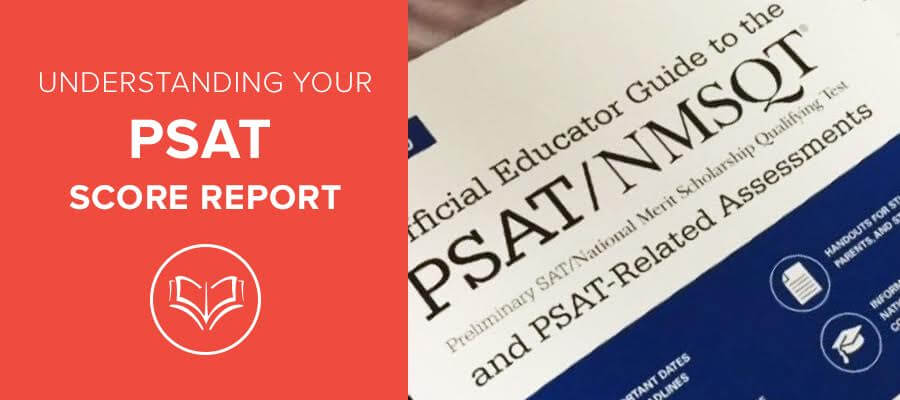

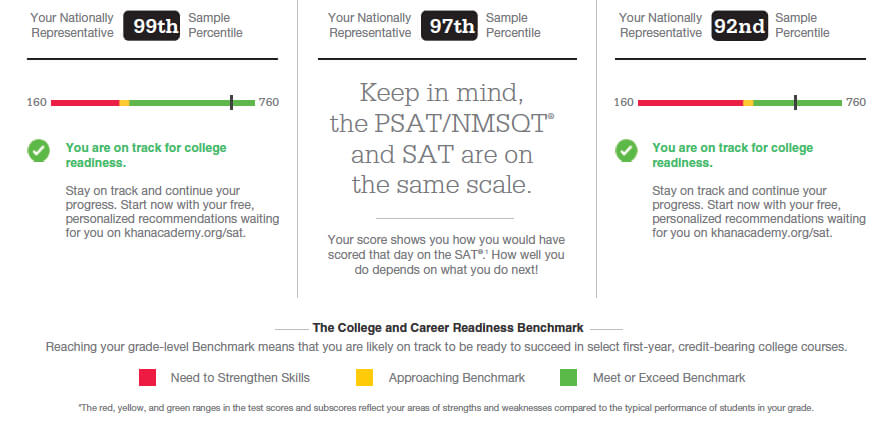


The information in this email is out of date. It says to get your National Merit score you “double” the sum of 3 scores (you say reading plus writing and language plus math) but now there are only TWO scores: 1) evidence based reading and writing; and 2) math. You aren’t leaving a very good impression when you give wrong information.
Hi Raquelle,
Thanks for the comment. You’re touching on a common misunderstanding when folks calculate the NMSC Selection Index. In addition to the EBRW and Math scores – which are added together to form your Total Score – College Board provides three distinct ‘Test Scores’ on a range from 3 to 38 (these are listed midway down on the second page of your paper score report). These three test scores include Reading, Writing and Language, and Math. You can actually use your Reading and Writing and Language Test Scores to figure out your EBRW score: just add the two scores together and multiply by ten.
You can locate National Merit Scholarship Corporation’s exact language for calculating the NMSC Selection Index on the third page of the paper report (a screen shot is also listed on our blog post above).
Thanks!
Matt
Any idea why the benchmark ranges (“Meet or exceeds college readiness”) are so different between the Section score and the Test score? For instance, in Math, the Section score benchmark for a Junior is 510, so one would expect the Test score benchmark to be 25.5 (510 / 20). However, the same online report details indicate that the “green zone” for the Math Test score for a Junior is 30. Why the difference? I can only find information from the College Board materials on the rationale behind the Section score benchmarks.
Kathleen,
I’m not 100% sure where you are seeing the 30, as I don’t think the report says exactly where the green starts and stops. I believe the difference is that on the Math Section score they essentially only show the benchmark as a sliver of the bar. Anything above it is green, but right on the button is yellow. When looking at the Test score, the yellow range is much broader. I believe they use the standard of +- a grade level, but I may be wrong there. I agree that the presentation is inconsistent and illogical.
The bottom line is that the benchmark is not particularly useful to an individual student. It is more relevant at the school or district level where aggregate performance can be assessed.
When I looked at daughter’s report, I noticed that two FREE RESPONSE answers for Math (without calculator) section are marked incorrectly because the answers are swapped. The answer for Q15 is against Q16 and vice-versa. The potential impact is commended scholar vs. a semi-finalist. I called CollegeBoard and they refused to do anything because the results are final. I escalated and still the same response. They recommended that she write to NMSC and see if they have anything to say.
What would you recommend? Current Math Score = 35.5/38; 710; 42/48 right answers.
Also, what would be the new Math score assuming that these two questions were answered correctly?
Thanks
Mantha
Mantha,
Your last question is the easiest to answer, so I’ll begin there. Based on the 42 correct = 35.5, I take it your daughter took the PSAT on October 11. According to the scales provided by College Board, 44 correct answers would net a 37 test score, or 740.
It would be very unusual for the testing agency to swap the answers your daughter entered. The tests are machine-graded based on the bubbled digits. Thus far, we haven’t received any reports of students’ having their grid-in answers swapped, so it’s unlikely for it to be an issue with the test or grading itself. I know how frustrating this must be – especially because she was so close to getting them correct!
I doubt that NMSC will have a different response from College Board but it’s worth a try…
You don’t mention your daughter’s verbal score, nor the state you’re in, so it’s hard to make a prediction about whether this will impact commended vs semi-finalist status for NMSC. You can view our predictions for state-by-state cutoffs here. Depending on where you live and what her verbal score is, there may still be hope that her 42 correct will get her over the line. And at the very least, having the knowledge to answer 44 of 48 questions correct is no small accomplishment. Congratulations to your daughter and good luck!
Thank you for the quick response. She got a 720 on verbal. The current index is 215. Based on the past year cut-off, I am assuming 215 is good for commended. State = NC.
NMSC rep said they would not be able to comment as the scores are reported by CollegeBoard (expected:-)) I will be happy to share the section of the score report where the answers are swapped if that is allowed by CB.
Thanks again!
S Mantha,
Correct, 215 will be Commended in NC. That’s somewhat disingenuous of NMSC. Yes, College Board reports the scores, but NMSC determines the cutoffs. The more honest answer is “we don’t comment on anything until September.”
Ash,
Thank you for the quick response. She got a 720 on verbal. The current index is 215. Based on the past year cut-off, I am assuming 215 is good for commended. State = NC.
NMSC rep said they would not be able to comment as the scores are reported by CollegeBoard (expected:-)) I will be happy to share the section of the score report where the answers are swapped if that is allowed by CB.
Thanks again!
Mantha,
Unless something changes dramatically, and we don’t expect that it will, 215 should land her well within commended status. I’m afraid I won’t be much help on the swapped answers – College Board also doesn’t listen to me 🙂
I’m not sure if this will take away the sting, but for what it’s worth, if she had received credit for those two questions, her ultimate SI would be 218. While that was the cutoff for NC last year, we are predicting that it will go up to 219 for the class of 2019.
I have a feeling that your daughter will be extra careful when filling in answers for the full SAT and as a result will do even better than her already impressive scores!